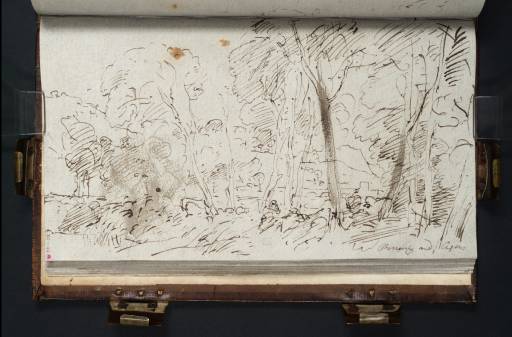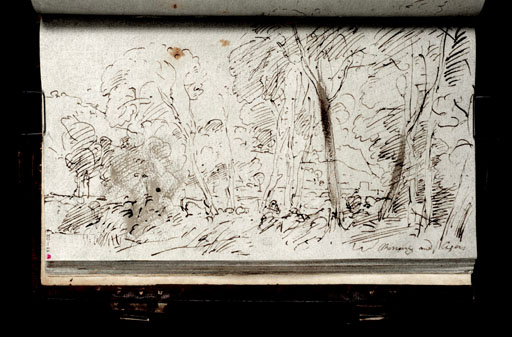Joseph Mallord William Turner Study for a Landscape with Mercury and Argus 1805
Image 1 of 2
Joseph Mallord William Turner,
Study for a Landscape with Mercury and Argus
1805
Joseph Mallord William Turner 1775–1851
Folio 54 Recto:
Study for a Landscape with Mercury and Argus 1805
D05575
Turner Bequest XC 54
Turner Bequest XC 54
Pen and ink on off-white wove paper, prepared with a grey wash, 150 x 258 mm
Inscribed by Turner in ink ‘Mercury and Argus’ bottom right
Inscribed by John Ruskin in red ink ‘54’ bottom left, descending vertically
Stamped in black ‘XC 54’ bottom left, descending vertically
Inscribed by Turner in ink ‘Mercury and Argus’ bottom right
Inscribed by John Ruskin in red ink ‘54’ bottom left, descending vertically
Stamped in black ‘XC 54’ bottom left, descending vertically
Accepted by the nation as part of the Turner Bequest 1856
References
1909
A.J. Finberg, A Complete Inventory of the Drawings of the Turner Bequest, London 1909, vol.I, p.236, XC 54, as ‘Study for a picture of “Mercury and Argus”’.
1982
Evelyn Joll and Martin Butlin, L’opera completa di Turner 1793–1829, Milan 1982, p.198.
1984
Martin Butlin and Evelyn Joll, The Paintings of J.M.W. Turner, revised ed., New Haven and London 1984, p.218.
1990
Kathleen Nicholson, Turner’s Classical Landscapes: Myth and Meaning, Princeton 1990, pp.147, 313 reproduced pl.11.
1990
Andrew Wilton and Rosalind Mallord Turner, Painting and Poetry: Turner’s ‘Verse Book’ and his Work of 1804–12, exhibition catalogue, Tate Gallery, London 1990, p.124.
1993
David Hill, Turner on the Thames: River Journeys in the Year 1805, New Haven and London 1993, p.162.
2009
Kathleen Nicholson, ‘Turner, Claude and the Essence of Landscape’, in David Solkin ed., Turner and the Masters, exhibition catalogue, Tate Britain, London 2009, p.63 reproduced in colour fig.25.
This sketch, extending very slightly on folio 53 verso (D40573), begins a series representing subjects from Ovid’s Metamorphoses which continue on the verso (D05576) and then on folios 55, 55 verso, 56, 57, 83 verso and 84 (D05577–D05579, D05581, D05615, D05616), and possibly others. As Nicholson observes, it is the ‘only one that [Turner] sketched out to any degree’ as well as being the most commonly represented by artists. This subject comes from Book 1 of the Metamorphoses. At centre left there is the hint of a cow, representing Io, who has been changed into a heifer and haunts the riverside, while in the shade on her right reclines her guardian, the hundred-eyed Argus. Io will eventually resume human form after being freed by Mercury, who murders Argus after lulling him to sleep with the story of Pan and Syrinx, the subject of folio 55. Turner painted a differently composed Mercury and Argus for the Royal Academy in 1836 (National Gallery of Canada, Ottawa).1 This sketch shows that he had the subject in mind for many years.
Turner’s readings and representations from Ovid, focusing on the passions and pitfalls of love, are discussed at length by Nicholson,2 who describes their first appearance in this sketchbook as ‘tentative’ but nevertheless revealing ‘an inventive search for narrative material that contrasts with his study of ancient history’ and providing ‘contrasts of emotion ranging from rude comedy to excessive grief to unfulfilled desire’. The shady landscape here, with its winding stream, introduces the ‘enchanted world’ of the Metamorphoses.
David Blayney Brown
August 2007
How to cite
David Blayney Brown, ‘Study for a Landscape with Mercury and Argus 1805 by Joseph Mallord William Turner’, catalogue entry, August 2007, in David Blayney Brown (ed.), J.M.W. Turner: Sketchbooks, Drawings and Watercolours, Tate Research Publication, December 2012, https://www


